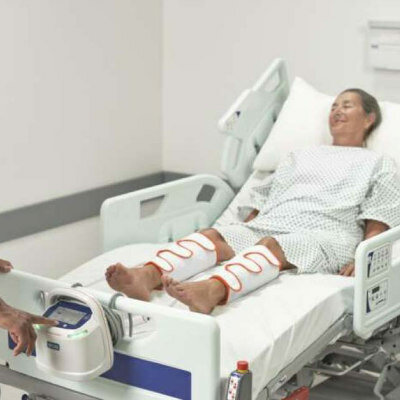Electrical Stimulation Therapies Promote Spinal Fusion
|
By HospiMedica International staff writers Posted on 15 Oct 2019 |
A new study suggests that electrical stimulation devices may produce clinically significant increases in arthrodesis rates among patients undergoing spinal fusion.
Researchers at Johns Hopkins University School of Medicine (JHU-SOM; Baltimore, MD, USA) conducted a systematic review of PubMed, Embase, and the Web of Science databases to study the effect of electrical stimulation technologies--including direct current stimulation (DCS), capacitive coupling stimulation (CCS), and inductive coupling stimulation (ICS)--on bone union following spinal fusion. In all, 11 preclinical studies and 13 clinical studies involving 2,144 patients were included in the meta-analysis. The primary endpoint was fusion rate at last follow-up.
The results revealed that among the preclinical studies, mean fusion rates were higher among electrical stimulation treated animals. The human clinical studies similarly showed that electrical stimulation increased fusion rates. But of the various modalities tested, only DCS improved fusion rates in both preclinical and clinical populations, while ICS improved fusion only in clinical studies. CCS was not found to be effective at increasing fusion. A subsequent sub-analysis showed increased fusion rates in patients with difficult-to-fuse spines, smokers, and multilevel fusions. The study was published on October 8, 2019, in the Journal of Neurosurgery: Spine.
“We were surprised by how large an effect these therapies have on spinal fusion,” said senior author Daniel Sciubba, MD, of the JHU-SOM department of neurosurgery. “It was also encouraging to see that the preclinical data aligned with the clinical evidence, which supports future translational research efforts in spine surgery. Ultimately, we hope our findings will help to inform patients and providers to enhance outcomes following spinal fusion.”
DCS requires implantation of a stimulation device, usually done at the time of spinal fusion surgery. Via electrodes, the battery-powered device delivers a small direct current of electricity to the area where fusion needs to occur. CCS is noninvasive; the external device uses two small electrode pads placed on the skin over the region of desired bone fusion, which produce an electrical field surrounding the region when powered by an external alternating current generator. ICS involves the use of coils placed on the skin to produce an electromagnetic field to induce bone fusion.
Related Links:
Johns Hopkins University School of Medicine
Researchers at Johns Hopkins University School of Medicine (JHU-SOM; Baltimore, MD, USA) conducted a systematic review of PubMed, Embase, and the Web of Science databases to study the effect of electrical stimulation technologies--including direct current stimulation (DCS), capacitive coupling stimulation (CCS), and inductive coupling stimulation (ICS)--on bone union following spinal fusion. In all, 11 preclinical studies and 13 clinical studies involving 2,144 patients were included in the meta-analysis. The primary endpoint was fusion rate at last follow-up.
The results revealed that among the preclinical studies, mean fusion rates were higher among electrical stimulation treated animals. The human clinical studies similarly showed that electrical stimulation increased fusion rates. But of the various modalities tested, only DCS improved fusion rates in both preclinical and clinical populations, while ICS improved fusion only in clinical studies. CCS was not found to be effective at increasing fusion. A subsequent sub-analysis showed increased fusion rates in patients with difficult-to-fuse spines, smokers, and multilevel fusions. The study was published on October 8, 2019, in the Journal of Neurosurgery: Spine.
“We were surprised by how large an effect these therapies have on spinal fusion,” said senior author Daniel Sciubba, MD, of the JHU-SOM department of neurosurgery. “It was also encouraging to see that the preclinical data aligned with the clinical evidence, which supports future translational research efforts in spine surgery. Ultimately, we hope our findings will help to inform patients and providers to enhance outcomes following spinal fusion.”
DCS requires implantation of a stimulation device, usually done at the time of spinal fusion surgery. Via electrodes, the battery-powered device delivers a small direct current of electricity to the area where fusion needs to occur. CCS is noninvasive; the external device uses two small electrode pads placed on the skin over the region of desired bone fusion, which produce an electrical field surrounding the region when powered by an external alternating current generator. ICS involves the use of coils placed on the skin to produce an electromagnetic field to induce bone fusion.
Related Links:
Johns Hopkins University School of Medicine
Latest Surgical Techniques News
- Robotic Assistant Delivers Ultra-Precision Injections with Rapid Setup Times
- Minimally Invasive Endoscopic Surgery Improves Severe Stroke Outcomes
- Novel Glue Prevents Complications After Breast Cancer Surgery
- Breakthrough Brain Implant Enables Safer and More Precise Drug Delivery
- Bioadhesive Sponge Stops Uncontrolled Internal Bleeding During Surgery
- Revolutionary Nano Bone Material to Accelerate Surgery and Healing
- Superior Orthopedic Implants Combat Infections and Quicken Healing After Surgery
- Laser-Based Technique Eliminates Pancreatic Tumors While Protecting Healthy Tissue
- Surgical Treatment of Severe Carotid Artery Stenosis Benefits Blood-Brain Barrier
- Revolutionary Reusable Duodenoscope Introduces 68-Minute Sterilization
- World's First Transcatheter Smart Implant Monitors and Treats Congestion in Heart Failure
- Hybrid Endoscope Marks Breakthrough in Surgical Visualization
- Robot-Assisted Bronchoscope Diagnoses Tiniest and Hardest to Reach Lung Tumors
- Diamond-Titanium Device Paves Way for Smart Implants that Warn of Disease Progression
- 3D Printable Bio-Active Glass Could Serve as Bone Replacement Material
- Spider-Inspired Magnetic Soft Robots to Perform Minimally Invasive GI Tract Procedures
Channels
Critical Care
view channel
CPR Guidelines Updated for Pediatric and Neonatal Emergency Care and Resuscitation
Cardiac arrest in infants and children remains a leading cause of pediatric emergencies, with more than 7,000 out-of-hospital and 20,000 in-hospital cardiac arrests occurring annually in the United States.... Read more
Ingestible Capsule Monitors Intestinal Inflammation
Acute mesenteric ischemia—a life-threatening condition caused by blocked blood flow to the intestines—remains difficult to diagnose early because its symptoms often mimic common digestive problems.... Read more
Wireless Implantable Sensor Enables Continuous Endoleak Monitoring
Endovascular aneurysm repair (EVAR) is a life-saving, minimally invasive treatment for abdominal aortic aneurysms—balloon-like bulges in the aorta that can rupture with fatal consequences.... Read more
Wearable Patch for Early Skin Cancer Detection to Reduce Unnecessary Biopsies
Skin cancer remains one of the most dangerous and common cancers worldwide, with early detection crucial for improving survival rates. Traditional diagnostic methods—visual inspections, imaging, and biopsies—can... Read morePatient Care
view channel
Revolutionary Automatic IV-Line Flushing Device to Enhance Infusion Care
More than 80% of in-hospital patients receive intravenous (IV) therapy. Every dose of IV medicine delivered in a small volume (<250 mL) infusion bag should be followed by subsequent flushing to ensure... Read more
VR Training Tool Combats Contamination of Portable Medical Equipment
Healthcare-associated infections (HAIs) impact one in every 31 patients, cause nearly 100,000 deaths each year, and cost USD 28.4 billion in direct medical expenses. Notably, up to 75% of these infections... Read more
Portable Biosensor Platform to Reduce Hospital-Acquired Infections
Approximately 4 million patients in the European Union acquire healthcare-associated infections (HAIs) or nosocomial infections each year, with around 37,000 deaths directly resulting from these infections,... Read moreFirst-Of-Its-Kind Portable Germicidal Light Technology Disinfects High-Touch Clinical Surfaces in Seconds
Reducing healthcare-acquired infections (HAIs) remains a pressing issue within global healthcare systems. In the United States alone, 1.7 million patients contract HAIs annually, leading to approximately... Read moreHealth IT
view channel
Printable Molecule-Selective Nanoparticles Enable Mass Production of Wearable Biosensors
The future of medicine is likely to focus on the personalization of healthcare—understanding exactly what an individual requires and delivering the appropriate combination of nutrients, metabolites, and... Read moreBusiness
view channel
Philips and Masimo Partner to Advance Patient Monitoring Measurement Technologies
Royal Philips (Amsterdam, Netherlands) and Masimo (Irvine, California, USA) have renewed their multi-year strategic collaboration, combining Philips’ expertise in patient monitoring with Masimo’s noninvasive... Read more
B. Braun Acquires Digital Microsurgery Company True Digital Surgery
The high-end microsurgery market in neurosurgery, spine, and ENT is undergoing a significant transformation. Traditional analog microscopes are giving way to digital exoscopes, which provide improved visualization,... Read more
CMEF 2025 to Promote Holistic and High-Quality Development of Medical and Health Industry
The 92nd China International Medical Equipment Fair (CMEF 2025) Autumn Exhibition is scheduled to be held from September 26 to 29 at the China Import and Export Fair Complex (Canton Fair Complex) in Guangzhou.... Read more












